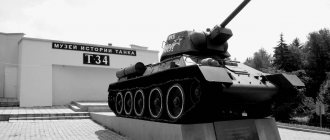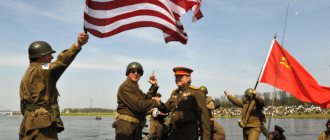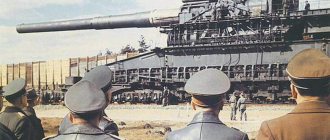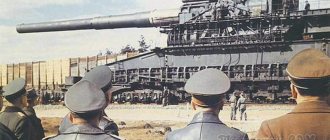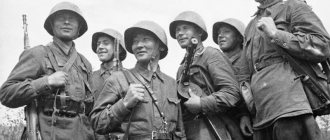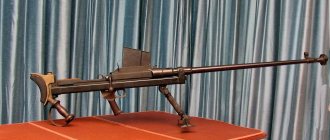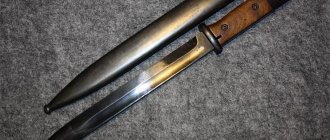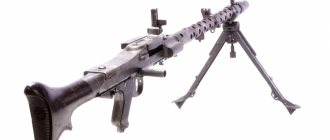By the end of the 30s, almost all participants in the coming world war had formed common directions in the development of small arms.
The range and accuracy of the attack was reduced, which was compensated by the greater density of fire. As a consequence of this, the beginning of mass rearmament of units with automatic small arms - submachine guns, machine guns, assault rifles. Accuracy of fire began to fade into the background, while the soldiers advancing in a chain began to be taught shooting on the move. With the advent of airborne troops, the need arose to create special lightweight weapons.
Maneuver warfare also affected machine guns: they became much lighter and more mobile. New types of small arms appeared (which was dictated, first of all, by the need to fight tanks) - rifle grenades, anti-tank rifles and RPGs with cumulative grenades.
StG 44
The Sturmgewehr assault rifle (StG 44) was mass produced from 1942 (1943) to 1945. Developed at the enterprises of Hugo Schmeisser.
Main features of the weapon:
- gas-type automation;
- 5.2 kg (weight with ammunition);
- 94/41.9 cm (total length/trunk);
- 7.92x33 mm (intermediate cartridge);
- 600 rounds per minute;
- 600-800 meters (sighting range);
- 685 m/s (initial bullet speed);
- 30 rounds in the magazine.
Advantages of the new model:
- increased aimed shooting range;
- use of a more powerful intermediate cartridge.
Flaws:
- relatively large mass;
- inconvenient sight;
- flame escaping from the barrel when firing.
Radio-controlled projectile "Henschel HS 293"
This anti-ship missile was probably the most effective weapon of the war. She destroyed many military destroyers and merchant ships. Measuring 4 meters in length and weighing almost a ton, they were produced in an edition of about 1,000 samples for the German Luftwaffe military aviation. Such an aircraft was a glider with a rocket attached below and 300 kilograms of explosives in the warhead.
Their main targets were unarmored warships. Then a model called "Frit X" was released for armored ships. After launching the bomb, after a few seconds the rocket flared up and slowly flew towards the intended target, leaving a trail behind it so that the machine gunner could observe the process. A serious disadvantage was that the bomber needed to maintain a straight trajectory along with a stable speed, flying at an altitude parallel to the target in order to maintain a distance line with the missile. And this meant that the bomber would not be able to escape pursuit of enemy bombers if they tried to intercept it. To evade pursuit, one would have to stop the attack.
Such missiles were first used in August 1943 and one of them even sank a British patrol ship . After some time, the armies of the countries of the anti-Hitler coalition found a way to use the radio frequencies of the rocket in order to interfere with their control. Of course, this significantly reduced their effectiveness for the rest of the war.
Mauser 98k
A repeating rifle with a short barrel was created in 1935 and was produced until 1945. The Wehrmacht had about 14 million of these weapons in service.
Characteristics:
- sliding shutter;
- 3.7-4.1 kg;
- 111 / 60 cm;
- 7.92 x 57 (rifle cartridge);
- 15 rounds per minute;
- 760 m/s (initial bullet speed);
- 5 rounds in the magazine;
- additionally equipped with a bayonet, a rifle grenade launcher and a curved attachment.
Pros:
- ease of operation;
- high destructive power.
Minuses:
- bulkiness;
- inconvenient in close-range combat.
Browning M1918
The Browning M1918 Automatic Rifle was a light machine gun in service with the US Army in 1938 and was used until the Vietnam War. Even though the US never set out to develop a practical and powerful light machine gun like the British Bren or the German MG34, the Browning was still a worthy model.
Weighing between 6 and 11 kg and chambered in .30-06 caliber, the Browning was originally intended as a support weapon. But when American troops faced heavily armed Germans, tactics had to be changed: for each rifle squad, at least two Brownings were now given, which were the main elements of the tactical decision.
The M1 carbine
The American M1 Carbine self-loading carbine was developed in 1938 by David Williams and was produced by Winchester and other arms factories until 1945. It was used to arm US soldiers.
Main features of the weapon:
- gas automatic;
- butterfly valve;
- 2.36 kg;
- 90.4 / 45.8 cm;
- 7.62 x 33 (unitary cartridge);
- 750 rounds per minute;
- 600 m/s;
- 15-30 rounds per magazine.
Advantages:
- the ability to shoot with one hand;
- designed for close combat.
Flaws:
- short sighting range;
- tangible dedication.
MP40
The German submachine gun was created by Heinrich Volmer on the basis of the EMP 36 and MP 38. Initially intended for tankers, paratroopers, and commanders. At the end of the war it was used by German infantry.
Characteristics:
- blowback;
- 4.8 kg;
- 83.3 / 24.8 cm;
- 9x19 mm Parabellum;
- 600 rounds per minute;
- 400 m/s;
- 250 meters (maximum range);
- 32-round magazine;
- muffler (optional).
Pros:
- compact size;
- long period of use in any conditions.
Minuses:
- designed for continuous fire;
- no protective casing (possible burns).
DP machine gun
It was outdated at the start of the war and earned a lot of reproaches. The fighters criticized him for everything. Inconvenient maintenance, fragile magazines, difficulty in carrying, low rate of fire, heavy weight...
(Photo: Semyon Fridland)
The DP machine gun sank into oblivion immediately after the end of the war - as soon as the country had the opportunity to mass produce a normal modern analogue as a replacement. But the Soviet industry produced hundreds of thousands of them, so several tens of thousands more diesel engines were installed on tanks.
Delivered on time.
Hand grenades
During the Second World War, fragmentation (offensive, defensive), anti-tank (cumulative, high-explosive) and special (high-explosive, incendiary) hand grenades were used. Each army armed itself with its own weapons.
Soviet soldiers had a huge variety of hand grenades. For example, offensive - RG-41/42, RGD-33 (0.4-0.5 kg, 20-25 m - radius of damage from fragments). Defensive F1 - 600 grams, lethal dispersion - 150 meters. Anti-tank RPG-6, RPG-40/41/43 weighed about 1.2 kg and penetrated 20-120 mm of armor.
The German anti-personnel fragmentation grenade Eihandgranate M39 weighing 220 grams had a fragmentation radius of only 3 meters. The offensive Stielhandgranate weighed 0.5 kg, and its fragments scattered 10-100 meters. A Hafthohlladung (anti-tank) grenade weighing 3 kg penetrated 140 mm armor.
Panzer VIII Maus
This tank, codenamed "Mouse", was the heaviest ever! This supertank weighed 188 tons. And it was its enormous mass that was the reason that it was never put into production. The estimated speed of this tank left much to be desired. Also, its weight could not even allow it to cross the bridge, but in certain circumstances the tank could float under water. Its main purpose was to push through the enemy’s defenses without any losses or damage. In the end, the Maus turned out to be too expensive to produce and extremely inconvenient.
Only two prototypes of the tank were created, but just before the end of the war the Germans destroyed them, again for fear of falling into Allied hands. The Russians managed to collect the wreckage and transport it to the USSR, where they were all assembled into a single tank. It is now in a tank museum west of Moscow.
Lee Enfield
The British repeating rifle was created in 1895 and improved during the war (Rifle No4 Mk I / Rifle No5 Mk I). The kit included a bayonet.
Weapon Features:
- longitudinal sliding gate;
- 3.9 kg;
- 113 / 63.5 cm;
- 7.7 mm (caliber);
- .303 British (rifle cartridge);
- 20-30 rounds per minute;
- 744 m/s;
- 1829 m (maximum range);
- magazine with 10 shells.
Advantages:
- high sighting range;
- 10 rounds in the chamber.
Flaws:
- relatively heavy weight;
- noisy shooting.
The best rifles of the twentieth century. Discovery selection
Individual long-barreled small arms with a rifled barrel are the main weapon of a soldier in any army. The American television channel Discovery once again pleased the world with its latest weapons rating, based on the results of which the best rifle of the 20th century was chosen. Despite some bias and bias in the Military Channel programs, I believe that it is always useful to get acquainted with a foreign perspective on a topic that interests us.
Each model was evaluated by military experts for accuracy of fire, combat effectiveness, originality of design, ease of use and reliability. The presented weapon models were created throughout the 20th century, which did not confuse the experts at all - in their opinion, good small arms have been used in the regular army for decades, and then get a second life in regional conflicts, which abound in the 20th century. To be convinced of the validity of these words, it is enough to recall the Mosin “three-line” model of 1891, the Kalashnikov assault rifle or the legendary “Colt” M1911 - the index speaks for itself, but even after 100 years the pistol does not seem like an anachronism and is still widely used throughout to the world.
By the way, this is perhaps the only rating with a completely predictable ending.
10th place - A rifle that strikes on the spot.
M14
automatic rifle Caliber: 7.62 mm Muzzle velocity: 850 m/s Rate of fire: 700-750 rounds/min. Magazine capacity: 20 rounds
During World War II, the American army faced a major problem: each infantry platoon used three types of small arms with different ammunition: the standard M1 Garand semi-automatic rifle (caliber 0.30-06), the .45-caliber Thompson submachine gun and the manual machine gun "Browning" M1918 (7.62 x 63 mm). The result of work on the topic “universal small arms” was the creation of the M14 automatic rifle; the weapon was put into service in 1957 (complete with an M76 under-barrel grenade launcher). The M14 used a full-size 7.62 caliber cartridge (powder charge 1.5 times greater than that of the AK-47), giving the rifle a longer effective firing range and high lethality of the ammunition.
However, in practice, the new rifle turned out to be of little use for combat: the extremely powerful ammunition did not allow firing in bursts without the use of a bipod - at a distance of 100 meters, the 3rd bullet in the burst went 10 meters above the initial aiming point. Most rifles were issued to soldiers with the fire mode translator removed - firing in bursts from the M14 was nothing more than a waste of ammunition. After suffering with the M14 for several years, the Americans adopted a new automatic weapon chambered for a low-impulse cartridge. In 1964, the combat career of the M14 as the main army rifle ended, but the high power and excellent accuracy of this unsuccessful machine gun made it possible to create a line of special rifles based on it - the M21 self-loading sniper rifle, the high-precision weapon for special forces - the M14 Enhanced Battle Rifle, the TEI M89 sniper rifle -SR for the Israel Defense Forces, rifle for the Lithuanian Armed Forces, etc.
9th place – First assault rifle
Automatic assault rifle
Sturmgewehr 44
Caliber: 7.92 mm Muzzle velocity: 650 m/s Rate of fire: 500 rounds/min. Magazine capacity: 30 rounds
Such a unique weapon that its creation was hidden even from Hitler. In the middle of World War II, the Wehrmacht came up with the idea of creating a new small arms that combined the high rate of fire of a submachine gun and the power of a long-barreled rifle. German designers found an ingenious solution - an intermediate cartridge 7.92 x 33 mm. Now the recoil did not tear the machine gun out of the hands, however, the effective range and destructive power of the ammunition were quite consistent with a classic long-barreled rifle. And thanks to the reduction in the mass of the cartridge, the wearable ammunition load has increased.
Alas, Uncle Adolf himself stood in the way of the successful project - fortunately for our soldiers, Hitler did not appreciate the advantages of the intermediate cartridge and closed the project. But the enormous firepower of the machine guns impressed the military so much that in 1943 their mass production began under the “leftist” designation MP-43. During one of the inspection trips, the leader of the German nation was surprised by the request of the soldiers - they needed more assault rifles. Despite the revealed deception, Hitler independently came up with a sonorous name for the new “wunderwaffe” - Sturmgewehr 44 (“Hurricane Rifle”).
Despite the primitiveness of the design, the German assault rifle rightfully receives high praise for the innovative nature of its design - there is still debate as to whether the legendary Kalashnikov assault rifle was created under the impression of the StG 44.
8th place – American centenarian
Springfield M1903
Bolt Action Rifle Caliber: 7.62 mm Muzzle Velocity: 820 m/s. Rate of fire: 10 rounds/min. Clip capacity: 5 rounds
American rifle of the early twentieth century, one of many successful designs created at that time. Accurate and reliable weapon. In 1941, American soldiers went into battle with the same rifles that their fathers had used 20 years earlier. There were simply not enough new M1 Garand rifles, and the Marines had to use the Springfield M1903 in battle, but objectively, the rifle at that time was not at all outdated, surpassing all Japanese models in its main characteristics. It was also used in Vietnam as a special sniper rifle (“What was there in this Vietnam!” the reader will exclaim, and he will be right - weapons from all over the world, from different time periods, fought there). These days, "Springfields" are carefully kept in many American families. A good weapon, but, in my opinion, the creators of the show could have found more interesting things for the rating. The Americans paid tribute to their traditions, and they have the right to rate them.
7th place - Back to front
Automatic rifle
Steyr AUG
Caliber: 5.56 mm Muzzle velocity: 940 m/s Rate of fire: 650 rounds/min Magazine capacity: 30 or 42 rounds
The exotic design and technology of the Austrian Steyr AUG rifle became a real challenge to army traditions.
The Armee Universal Gewehr small arms complex, which appeared in 1977, represented a new direction in the design of small arms - bullpup assault rifles, in which the magazine and bolt assembly are located behind the fire control handle and trigger. This made the rifle light and compact, and also increased the accuracy of fire. Other interesting features of the Steyr AUG include: a set of quick-release barrels of different lengths (replacement takes a dozen seconds), a built-in low-magnification optical sight, the absence of a fire mode translator (the selection of modes is carried out by the depth of the trigger press), a choice of the direction of ejection of cartridges - for the first time, a weapon has been adapted for right-handers and left-handers. But, despite its outstanding technical characteristics and excellent Austrian quality, the Steyr is not widely used in the world - in addition to the Austrian army, it is produced under license in Australia, used in some Arab countries and in the US Coast Guard. The unusual appearance of the machine scared off most potential customers.
By the way, the experts were wrong - the first automatic rifle built according to the bullpup design was the Korovin assault rifle, created in 1945.
Unfortunately, the unfinished design and the overall low technical level of performance did not allow it to successfully pass tests. 6th place - Hitler's favorite rifle
Mauser K98k
bolt action rifle Caliber: 7.92 mm. Muzzle velocity: 860 m/s. Rate of fire: 10-15 rounds/min Magazine capacity: 5 rounds
The Mauser K98 rifle, adopted by the Reichsheer in 1898, absorbed the most promising achievements of the then weapons science. These included smokeless powder, clips of cartridges that could simply be inserted into the magazine, and, finally, the bolt-action bolt action—quick and simple, still used in most hunting rifles today.
It is not surprising that the rifle pleased the young corporal A. Hitler.
In 1935, a shortened version of the Mauser K98 was adopted by the Wehrmacht army, receiving the name Mauser K98k. In 1943, when preparing the assassination attempt on Hitler (it was planned to land two elite snipers in the area of Hitler’s Alpine residence), British intelligence was faced with the question: which rifle to use in the operation. The answer was clear: only the Mauser M98k due to its high accuracy. Gradually the situation changed, and along with it, plans to eliminate the mustachioed Fuhrer changed. In 1944, the British canceled the operation altogether: Hitler, with his stupid orders, was causing more harm to Germany than good.
On May 9, 1945, the history of the Third Reich ended, but the history of the Mauser K98k continued. The kosher rifle became the main small arms of the Israel Defense Forces (although the Americans are disingenuous - in the first years of the IDF’s existence, its small arms were a hodgepodge from all over the world, and the Mauser was far from the main one there, but not the last).
5th place – Right hand of the free world
Automatic rifle
FN FAL
Caliber: 7.62 mm Muzzle velocity: 820 m/s. Rate of fire: 650-700 rounds/min Magazine capacity: 20 rounds
The FN FAL assault rifle has become a symbol of the struggle of Western civilization for the ideals of freedom and democracy - the weapon was supplied to 70 countries around the world, and is still produced in the USA. The “Big Belgian Barrel” was originally designed for shortened ammunition, but due to the standardization of weapons within the NATO bloc, it was converted to a powerful American cartridge of 7.62 x 51 mm. Despite the excessive power, the Fabric National engineers managed to achieve more or less acceptable accuracy of fire in automatic fire mode. The result is a heavy classic rifle with enormous destructive power, reliable and easy to use.
The FN FAL was the main small arms of the Israel Defense Forces during the Six-Day War, and was used in the jungles of Vietnam by units of the Canadian and Australian armies, where it showed itself better than the American M16.
A funny embarrassment happened during the Falklands conflict - British marines and Argentine soldiers shot at each other from FN FAL. 4th place – Weapons of the winners in World War II
Semi-automatic rifle
M1 "Garand"
Caliber: 7.62 mm Muzzle velocity: 860 m/s Rate of fire: up to 30 rounds per minute. Clip capacity: 8 rounds
A true legend, a symbol of that great generation of Americans. A soldier armed with an M1 felt real power in his hands - a semi-automatic eight-shot rifle was the best weapon in the world for an infantryman at that time. The M1 Garand, named after Canadian engineer John Garand, entered service in 1936 and remained the primary rifle of the US Army until 1957.
World War II poster - US flag has 48 stars (missing Alaska and Hawaii)
When millions of American soldiers went to fight on foreign shores, the M1 rifle suddenly developed a curious drawback: to increase the rate of fire, John Garand used automatic ejection of an empty pack in his weapon - after the eighth shot was fired, the clip instantly flew out of the rifle's bolt mechanism with a clang. A very convenient function in peacetime, but enemy soldiers quickly realized what a specific sound meant - the American GI was unarmed. But not everything is so simple - perhaps the cunning Marine clicked the spare clip on the bolt and threw the pack on the ground, waiting for the deceived Japanese to raise his head from cover.
Seriously speaking, the M1 Garand showed its best performance in a variety of climatic conditions - in the jungles of tropical islands, the sands of the Sahara or the snowdrifts of the Ardennes. There were no complaints about the reliability of the rifle. The Garand was simple, powerful and had excellent shooting accuracy. Soldiers armed with the M1 fought on all fronts of World War II; the rifle was used in Korea and, despite being officially retired, was often seen in the jungles of Vietnam.
3rd place – In the service of the Empire
Lee-Enfield SMLE
bolt action rifle Caliber: .303 British (7.7 mm) Muzzle velocity: 740 m/s Rate of fire: 20-30 rpm Magazine capacity: 10 rounds
Afghan Mujahid with Lee-Enfield SMLE, Kunar Province, 1985
For non-automatic rifles, the Lee-Enfield SMLE had a simply terrifying rate of fire thanks to a successful bolt design and a high-capacity magazine capable of holding 10 rounds (in this indicator, the Lee-Enfield SMLE was the leader throughout the first half of the 20th century). A trained shooter could fire up to 30 shots from it in a minute, turning a target into a sieve at a distance of 200 m. The “Crazy Minute” was one of the most spectacular numbers during the demonstration performances of the British Army.
The Lee-Enfield SMLE's fire density is comparable to that of modern semi-automatic rifles and carbines. It is not surprising that these weapons survived two world wars and were used all over the world for a long time, protecting the interests of the British Empire. Between 1907 and 1975, 17 million of these killer rifles were produced.
2nd place – Black rifle
M16
automatic assault rifle Caliber: 5.56 mm Muzzle velocity: 1020 m/s. Rate of fire: 700-950 rounds/min Magazine capacity: 20 or 30 rounds
In 2003, alarming information began to arrive from the territory of occupied Iraq - too many Iraqi soldiers were killed by head-shots.
The results of numerous brutal reprisals against prisoners are evident. But why are the bodies of the murdered lying everywhere? Did the experienced punishers really not even bother, at least for the sake of decency, to remove the evidence in the face of numerous international observers? Iraqi soldiers were shot in the head where they made their last stand, leaning out of tank hatches and house windows, in trenches and on barricades. Often in equipment and with weapons in their hands. The Coalition Forces command explained this paradox by the superior accuracy of the M-16 rifles and the excellent training of American snipers. Thousands of people around the world stopped breathing thanks to the M16.
Comic for American soldiers: how to properly clean and disassemble the M16, 60s.
Decorated with taste .
For 50 years, the M16 has been an indispensable attribute of the American soldier. Despite the lower barrel energy, the power of the low-pulse 5.56 x 45 mm cartridge was quite enough to stop a person; often, when it hit the body, the bullet began to tumble unimaginably, further enlarging the wound channel. At the same time, recoil was reduced and shooting accuracy increased. The design of the automatic rifle is made of plastic and alloyed aluminum, thanks to which the M16 had a minimum weight - only 2.88 kg without a magazine.
The "Black Rifle" was the nickname given to the M16 by American soldiers in Vietnam, but despite its stylish appearance, the new weapon had many problems. The machine mechanism did not tolerate dirt and sand. The problem was solved by sealing the rifle, for example, the window for ejecting cartridges is closed with a spring-loaded curtain. In a word, you need to try to get dirt inside the M16.
The Americans admit that the M16 has excellent shooting accuracy, but this “toy” also requires careful handling from its owner. The American assault rifle is not suitable for a partisan detachment; it is created for a professional army, in which cleaning and lubricating the weapon is the daily duty of every soldier. In return, the M16 makes it possible to shoot an enemy in the head from 500 m.
1st place – Thirty charges of rock and roll. The bad guys' weapons.
Automatic assault rifle AK-47
Caliber: 7.62 mm Muzzle velocity: 710 m/s. Rate of fire: 600 rounds/min Magazine capacity: 30 rounds
A universal killing machine, the most deadly weapon ever created by man - according to statistics, the number of people killed with a Kalashnikov assault rifle is many times greater than the number of victims of atomic bombings or killed by any other method.
1/5 of the world's small arms reserves are Kalashnikov assault rifles. Countless clones and modifications, 60 years of combat service in all hot corners of the planet. In terms of the number of armies that have adopted this weapon, Kalashnikov can only compete with the FN FAL. The AK-47 appears on the national flag of Mozambique. How did the Russians manage to achieve SUCH an impressive result? American experts smile and shrug – this is probably the only time America lost to smithereens to the Soviet Union. The reasons for the wild popularity of the Kalash are low cost, ease of maintenance, reliability, reliability and once again RELIABILITY.
Osama Bin Laden and his Kalashnikov
Covered with rust and dirt, buried in sand or thrown with all its might onto the ground - the Kalashnikov assault rifle continues to fire in any conditions. All you need to service it is a finger and a rag. It is no coincidence that experts compared shooting from a Kalash to the game of rock and roll: the same drive, the same reckless hacking without stopping. True, experts found a “flaw” in the legendary assault rifle - a not very attractive design (but for some reason the ugly appearance of the Kalashnikov assault rifle did not at all affect its worldwide commercial success). Thanks to its simplicity and effectiveness in any conditions, the Kalash has become a faithful companion of bandits, partisans and terrorists around the world. “Kalash” was promoted with all its might in the United States - Hollywood specially worked to create its negative image: clearly, “Kalash” is the weapon of the bad guys.
The same rating. AK-47 is again in first place:
Note: Many phrases and statements in this text may seem strange to you. The author just translated the funniest opuses of Military Channel experts.
Luger PO8
The pistol was developed in 1898 by the Austrian Georg Luger. The Model 1908 is compact in size, has a comfortable grip, and allows for precise shots with high lethal power.
Peculiarities:
- barrel recoil (short stroke);
- 1 kg (full set);
- 21.7 / 10 cm;
- 9x19 mm Parabellum;
- 8 rounds in a box magazine;
- 30 rounds per minute;
- 320 m/s.
Pros:
- comfortable handle;
- comfortable aiming.
Minuses:
- uncomfortable trigger;
- the structure is not protected from dirt and sand getting inside.
KA-BAR combat knife
The Ka-bar knife was created as a weapon against grizzly bears (“kill a bear”). In 1942, the American company Camillus mass-produced this model for the Marine Corps. The knife was used in close combat.
Weapon characteristics:
- single-edged steel blade;
- false blade on the butt;
- leather scabbard;
- stacked leather handle;
- 560 g;
- 30.8 cm (total length);
- 17.7 cm (blade).
Advantages:
- sharp blade;
- the ability to deliver fatal blows.
Flaws:
- the leather of the handle deteriorated under the influence of salt water;
- The blade became dull over time.
Automatic Thompson
During the war, an improved M1 model was created on the basis of the Thomson submachine gun (1916). The new American machine was lighter than the basic design and easier to operate.
Main features of the weapon:
- blowback automatic;
- L-sight;
- 4.4 kg;
- 0.81 m;
- box magazine for 30 rounds;
- 45 ACP/.30 Carbine (Thompson Carbine);
- 285 m/s;
- 600-700 (rate of fire).
Advantages:
- the ability to conduct continuous fire;
- reliability.
Flaws:
- bulkiness;
- heavy weight.
Horten Ho 229
The Ho 229 is known as the world's first stealth bomber. This aircraft could carry a load of 1000 kilograms at a speed of 1000 kilometers/hour. Two German enthusiasts became its inventors. The Horten brothers said they mixed wood glue with dust to absorb electromagnetic waves. Thus, the engineering brothers made a big breakthrough in stealth technology.
The aircraft was successfully tested in 1944 and 20 aircraft were ordered for production. But by the end of the war, the Allies were only able to discover its prototype and an unfinished model. Reimar Horten fled to Argentina after the war, where he continued his work until his death in 1994.
Walter Horten became a general in the German forces and died in 1998. The Horten Ho 229 became the model for the production of new US Air Force bombers, and the original itself is now in the National Air Museum in Washington.
PPSh-41
The submachine gun was developed at the beginning of the war by the Soviet designer Shpagin, which is why it is called PPSh-41. 55% of the Red Army soldiers were armed with these weapons.
Description:
- machine gun for firing bursts and single shots;
- blowback;
- 3.6 kg (without ammunition);
- 84.3 / 26.9 cm;
- 7.62x25 mm TT;
- sector magazine (35) or drum (71);
- 1000 (rate of fire);
- 500 m/s.
Pros:
- hitting a target at a distance of 200 m;
- good performance in close and ranged combat.
Minuses:
- high consumption of ammunition;
- bulkiness (models with a drum magazine).
Radio controlled bomb Ruhustahl SD 1400 "Fritz X"
It was called "Fritx X", a radio-controlled air-launched bomb. Like the aforementioned HS 293, this missile is also designed to bomb ships, but only well-armored ones. She had excellent aerodynamics, four small wings and a tail. Fritx X looked very menacing in the eyes of his opponents. The ancestor of the modern bomber could withstand 317 kilograms of explosives and was based on a radio command signal system, making it one of the most precision-guided weapons in the world.
These bombers were deployed to Malta and Sicily in 1943 and were highly effective. On September 9, 1943, the Nazi command sent planes to defend besieged Rome. The bombers sank several British and American warships. Only 200 bombs out of the available 2000 were dropped on the target. The whole difficulty lay in the inability of the bombs to change direction. And therefore, to attack targets, planes had to fly directly above them, which made them vulnerable to enemy raids.
M1 Garand
The American self-loading rifle was the main weapon of the US infantry. The model was developed by Canadian-American designer John Garand in 1929. At the beginning of the war, the rifle was modernized (the gas exhaust system was improved).
Weapon characteristics:
- automation (powder gas removal);
- 4.32 kg;
- 110.5 / 61 cm;
- 7.62x63 mm (7.62x51 mm);
- 8-cartridge pack;
- 865 m/s.
Advantages:
fast recharge;
- high destructive power.
Flaws:
- the ejection of an empty pack was accompanied by a ringing sound;
- heavy weight.
Three-line Mosin
The three-line rifle was developed by Russian designer Mosin back in 1891 and was used during the First World War. Before the start of the Second World War, the model was improved.
Characteristics:
- sliding shutter;
- 3.5 kg;
- 102 / 51 cm;
- magazine for 5 ammunition;
- 7.62x54 mm;
- 10 rounds per minute;
- 820 m/s;
- bayonet.
Pros:
- high killing power;
- reliability in any conditions.
Minuses:
- bulkiness;
- There were problems during recharging.
SVT-40
The Tokarev self-loading rifle was adopted for service in 1940 and was distinguished by a shortened bayonet. During World War II, this model was the main weapon of the Soviet infantry.
Peculiarities:
- removal of powder gases;
- 3.9 kg;
- 122.6 cm;
- 7.62x54 mm;
- 10 rounds in a box magazine;
- 830 m/s;
- 500 m (sighting range).
Advantages:
- good shooting accuracy;
- high destructive power.
Flaws:
- sensitivity to pollution and frost;
- demands on the quality of gunpowder.
Flamethrower FOG
In the field of applied ground flamethrowing, the USSR reached considerable heights even at the start of the war. A well-planned ambush with high-explosive flamethrowers could disrupt an enemy attack. The FOG design was so successful that the Germans simply stole the Soviet design, something that Reich military science had done with every other nation's vast array of breakthrough weapons.
The simple, unpretentious design survived the war to victory - and in German cities, the seemingly purely sapper design, hastily attached with wire to the window sill, regularly spat across the streets from apartment to apartment.
PPS-42
The Sudaev submachine gun was developed in 1942 and was used by the Soviet army during the Second World War. This weapon replaced the bulky PPSh.
Characteristics:
- automatic (blowback);
- 3.63 kg;
- 91 cm;
- 7.62x25 mm TT;
- 500 m/s;
- 200 m (sighting range);
- 35 rounds per box magazine.
Pros:
- easy-to-use design;
- high destructive power.
Minuses:
- no single fire mode;
- relatively heavy weight.
PPD-40
The Degtyarev system submachine gun was created in 1940 based on the 1934 model. PPD-40 is the most popular weapon of the Second World War.
Peculiarities:
- automatic (blowback);
- 5.45 kg (total);
- 78.8 cm;
- 7.62x25 mm TT;
- 480 m/s;
- drum magazine for 71-73 rounds.
Advantages:
- shooting in single and short bursts;
- lethal force was maintained up to 800 meters.
Flaws:
- when firing frequently in bursts, overheating occurred;
- bulkiness.
Landkreuzer P.1000 Ratte
Did the previous tank seem big to you? Compared to this model, he is just a small toy. This super-mega tank was the largest and heaviest tank of Nazi Germany. According to all plans, it was supposed to weigh 1,000 metric tons and be equipped with artillery, which is only found on military destroyers. Just imagine a car 35 meters long, 14 meters wide and 10 meters high! To operate such a tank, 20 personnel were required. Such dimensions were a real headache for engineers, because due to such a mass, not only bridges, but also the road would begin to crumble before our eyes.
Engineer Albert Speer, who developed the machine, considered the intended design ridiculous. Its construction would be absolutely unprofitable. However, despite heated discussions and excuses, Speer canceled the project in 1943. Even the prototype of the tank was not fully developed. But, by that time, the command of the Armed Forces had already taken up the development of another tank, the Landkreuzer P.1500 Monster.

